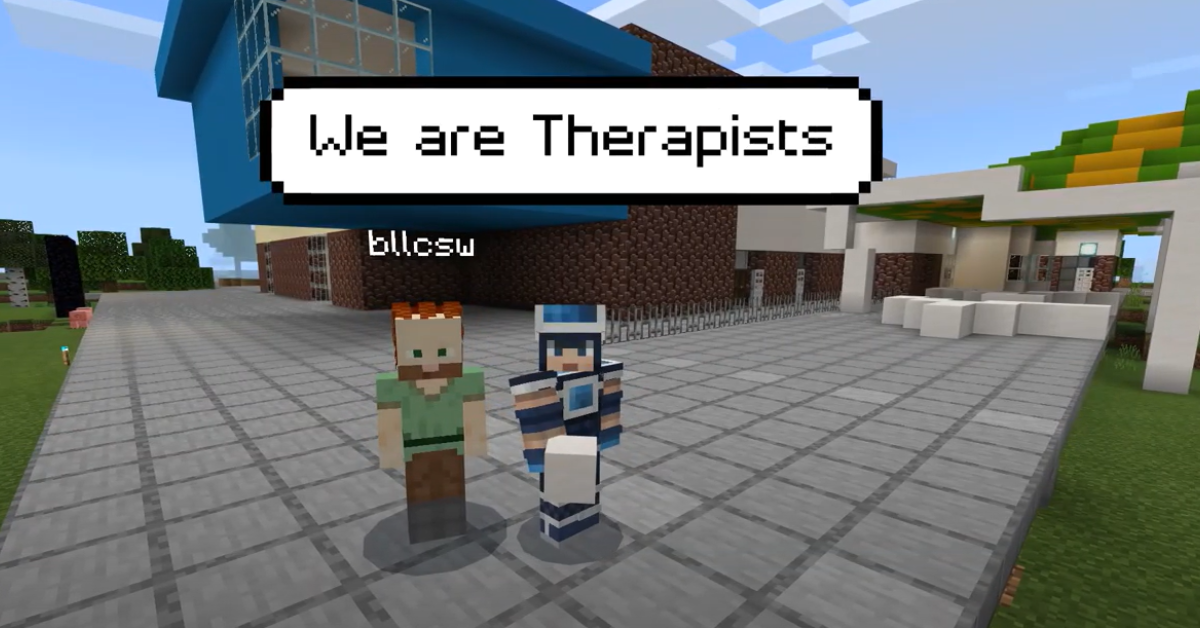Braulio Rivera, LPC, who works as a child therapist at WellPower’s Dahlia Campus for Health and Well-Being, typically uses a selection of toys, games, movement and other elements to help engage young people in treatment. In March 2020, all of these tools were lost as the world hunkered down and adapted to a virtual world.
During a telehealth session early in the pandemic, Rivera asked a distracted child what he was doing, and he replied, “I’m playing Minecraft. Do you want to join my world?”
This was particularly symbolic to Rivera. “As a therapist, we want to go into the world of a child,” he said. “We want to know what it looks like so we can provide support from within that world.”
Rivera asked his then-7-year-old daughter what she knew about Minecraft. She told him about the game and how you build a world and have others join. From there Rivera and his daughter built a replica of Dahlia Campus for Health and Well-Being in Minecraft. And nearly overnight, in a world of uncertainties, Rivera recreated a familiar environment for the children he served.
Check out Minecraft in action with our Building Connections Video
A novel digital intervention
Rivera met with kids individually in Minecraft when the digital tool was first launched. He and the child would log on to Minecraft, the child would navigate through Dahlia Campus, check in at the front desk and then patiently wait for Rivera.
Rivera would come out to greet them and their little avatars would walk down the hall to his office. An avatar in Minecraft refers to the in-game representation of the player themselves. Rivera noticed that after kids entered Minecraft, they would set their controllers aside and express that they had a tough week. Playing Minecraft together created a shared experience between Rivera and the child and ensured a safe space to be open about their difficulties.
Healing in community
The natural progression for Rivera was to consider this service for group therapy in addition to individual therapy. Rivera started his career in substance use treatment where treatment is mostly group orientated. “I wanted to be able to make this into a group or a community because we know that community heals,” said Rivera. “Just by being in the community you are healing and then when we add therapy, it amplifies it.”
Rivera and his team looked at how to make group settings work from a technology, privacy and operations standpoint, and from there the first Minecraft group launched. In the beginning, they worked with children whose social interactions were disrupted by the pandemic. Unexpectedly, Rivera and his team also found children who never had social connections to begin with. The pandemic didn’t interrupt their connections, they were already lonely and isolated. Since its inception in 2020, Rivera and his team have run 13 different groups. They frequently discover specific populations who could benefit from this digital service including children who are neurodivergent, LGBTQ+ and Spanish speakers.
Check out Minecraft in action in this video featuring our La Communidad Group
Working through trauma in a safe space
Rivera began to think about using this intervention in trauma work. Trauma work is the therapeutic process of addressing and healing the effects of exposure to an incident or series of events that are emotionally disturbing or life-threatening. Rivera convinced Julie Perling, WellPower’s Eye Movement Desensitization and Reprocessing (EMDR) trainer to start an EMDR group.
EMDR is a therapy that enables people to heal from the symptoms and emotional distress that are often the result of disturbing life experiences. “In the EMDR world, we spend a lot of time creating a safe space that you can seek refuge and make your own,” said Rivera.
“We can get to trauma in two strong ways,” said Rivera. “We can have a strong modality like EMDR which focuses on individual therapeutic processing. And we can have the support of community which provides a broader social context to reinforce healing and resilience.”
Check out Minecraft in action in our EMDR Video
Creating an equitable, digital service
There is an equity lens that runs through the design and coordination of this program. “Minecraft was picked as it requires the least amount of internet necessity and computing power and this tends to be aligned with our families experiencing a low-income situation,” said Rivera.
Transportation to get children to groups can be difficult, another reason why this digital service works well. Minecraft is available on various platforms including computers, consoles and mobile devices, making it accessible to a wide range of people. It also allows cross-platform play, allowing players on different devices to play together.
What the kids had to say about the Minecraft groups
The results of an evaluation from a Minecraft group that lasted 20 weeks in 2021 showed that the group was successful. Both clinicians and group members said that they thought the Minecraft group was fun and helpful. There was a sense of community and they felt they were able to share their experiences and build strong relationships within the group.
The evaluation also revealed that the group’s success did not rely on participants having the same diagnosis. Instead, it depended on their shared experiences of social isolation caused by their diagnosis, the pandemic or being physically distant from others. The use of Minecraft helped enhance their social connections.
The Minecraft Team at WellPower
Rivera concludes that his colleagues Julie Perlin, Blake Lohman, Julia Solari, Edgar Fernandez and Cindy Gonzalez were all instrumental in making this program possible.
Leveraging the timeless appeal and cultural relevance of Minecraft, Rivera and his team are committed to utilizing the digital world to continue fostering community among young people throughout Denver.


